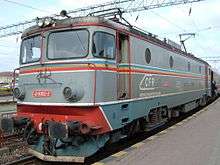CFR Class EA
CFR LE Clasa 40/41/42
 |
|
|
| Specifications |
|---|
| AAR wheel arr. |
C-C |
|---|
| UIC class |
Co'Co' |
|---|
| Gauge |
1,435 mm (4 ft 8 1⁄2 in) |
|---|
| Driver dia. |
1,250 mm (4.1 ft) |
|---|
| Wheelbase |
Rigid: 4,350 mm (14.27 ft)
Overall: 10,300 mm (33.79 ft) |
|---|
| Length |
19,800 mm (64.96 ft) |
|---|
| Width |
3,000 mm (9.84 ft) |
|---|
| Height |
4,500 mm (14.76 ft) |
|---|
| Axle load |
20 t (44,092.45 lb) |
|---|
| Loco weight |
120 t (264,554.7 pounds) |
|---|
| Electric system(s) |
19.5-27.5 kV 50 Hz AC Catenary |
|---|
| Current collection |
Overhead AC with simetric/asimetric dual pantographs |
|---|
| Traction motors |
6 × 850 kW (1,140 hp) |
|---|
|
| Performance figures |
|---|
| Maximum speed |
120 km/h (75 mph) Class 40
160 km/h (99 mph) Class 41
200 km/h (120 mph) Class 42 |
|---|
| Power output |
5,100 kW (6,800 hp) |
|---|
| Tractive effort |
412 kN (93,000 lbf)
392 kN (88,000 lbf) |
|---|
|
|
|
The CFR Class 40/41/42 is a class of electric locomotives built for the Romanian Railways (CFR) for use on the Romanian electrified network. Over 1000 Class 40s were constructed by Electroputere (EP) under ASEA licence in EPs Craiova Works from 1967 to 1991.
Entering service in 1965, the Class 40 also operated on private railroads after the repeal of CFRs monopoly on rail transport. The vast majority of al the engines are still in service, as of 2013.
History
.JPG)
CFR Class 41-0242 in Sinaia
Following the plans of Communist Party, the Romanian railway network was to reduce its operating steam engines to under 25% of the total number of engines. Since the start of dieselisation in Romania and the electrification of the first railway sector between Bucharest and Brașov, communist ambitions were to improve local industrial capacities, remove dependency on outside sources and reduce conventional fuel consumption.[1] Since Romania did not develop an electrical locomotive to suit these ambitions, foreign partnerships were searched to design and home build a working horse for the Romanian Railways. Even if Romania has previously signed partnerships with Sulzer for the development of its diesel-electric locomotives, for the electric locomotive a partnership was signed with Sweden's Allmänna Svenska Elektriska (ASEA).
Builders
Allmänna Svenska Elektriska AB
Once the success of the Ra engine series made by ASEA and NOHAB for SJ was proven, electronical advances in the 1960s have given the opportunity for the development of a new series of electric locomotives, the Rb series, that could be exported.[2] The result was an agreement between ASEA, NOHAB and SJ where six test engines were delivered. The testing of the Rb1 was successful and based on this exports were made to the Yugoslav Railways (JŽ class 441) and Romanian Railways (CFR Class 40). The first 10 engines to run on the Romanian railway system were built by ASEA and NOHAB in Sweden and soon after, in 1966 Romania bought a manufacturing licence for these locomotives to be built in Craiova, at Electroputere. Production in Craiova started in 1967.[3]
Electroputere Craiova
All the engines built in Romania after 1966 have been identified by the EA designation. These are all 6 axle, 5100 kW engines, produced in a number of over 1000 units between 1967 and 1991. Electroputere (EP) manufactured both the mechanics and electronics of the engines, after mechanics for the engines stopped to be manufactured in Reșița, EP took care of the entire manufacturing for these engines and had a yearly output of 150 engines per year.

Only CFR Class 42 locomotive ever built. This prototype can reach at 200KM/H
References
|
|---|
|
| Electric locomotives: | | |
|---|
|
| Diesel locomotives: |
- CFR 60
- CFR 62
- CFR 63
- CFR 65
- CFR 67/68
- CFR 69
- CFR 73
- CFR 80
- CFR 81
- CFR 82
- CFR 83
- CFR 84
- CFR 85
- CFR 88
- CFR 95
|
|---|
|
| DMUs: |
- CFR 77
- CFR 78
- CFR 79
- CFR 92
- CFR 96
- CFR 98
|
|---|
|
| EMUs: | |
|---|
|
| Withdrawn steam locomotives1: | |
|---|
|
|


.jpg)